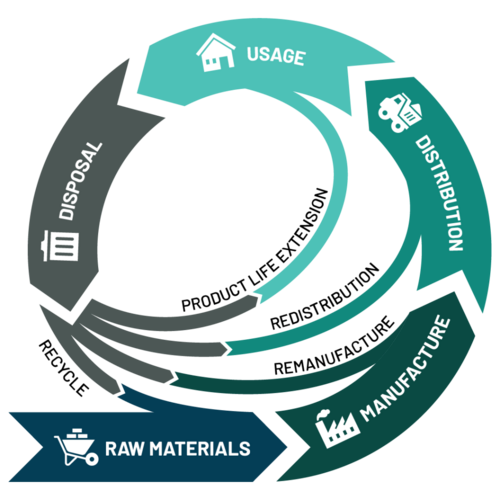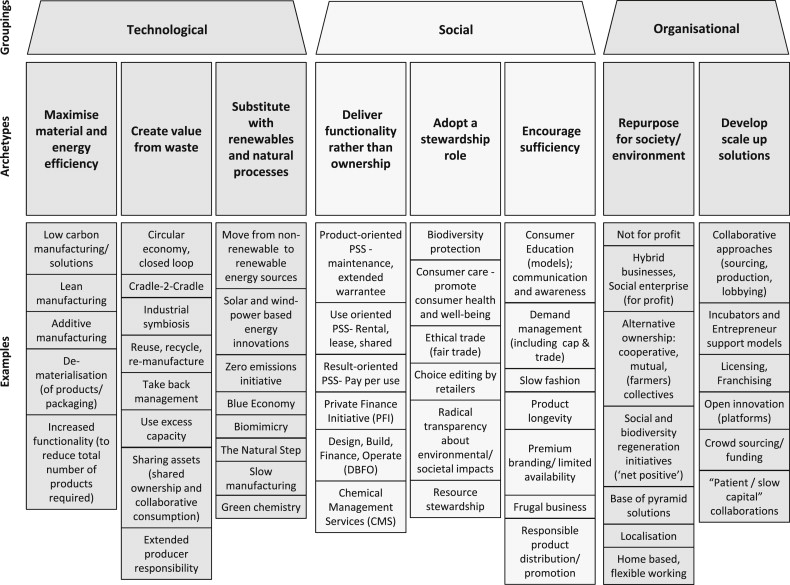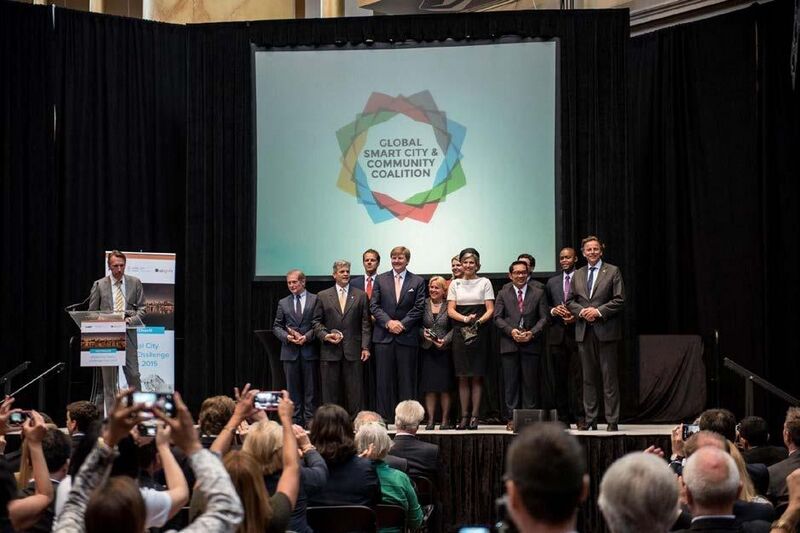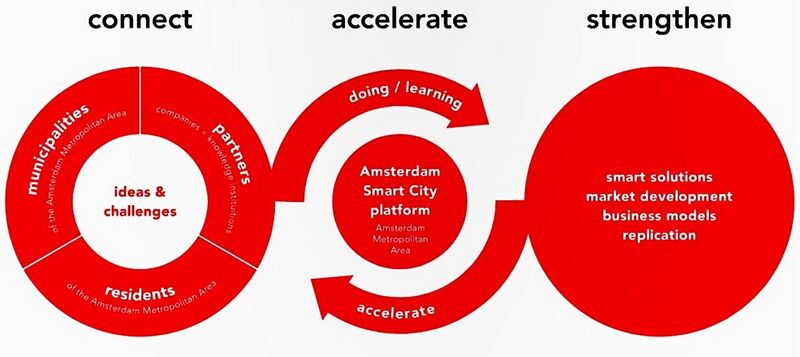Waste Working Group Framework Best Practices
When a pick up is missed at our homes or when street cans are overflowing, or when we see and smell the debris left by fans the morning after our local team wins the championship littering the streets, we blame the city for not doing its job. Private sector contracts for service are based upon the frequency of pick-ups that need to be made, regardless of how full a container might be at any given time. Rarely, do we care about how much waste we generate or about what happens to the materials once they are tossed.
Innovative might not be the first word that comes to mind when one thinks about the waste management industry. However, most do not typically think about a city’s responsibility to pick up the discards that we place curbside once or twice a week, to remove whatever we place in public cans, to clean the mounds of trash that fill our streets after special events -- each action to be completed within an expected timeframe. When a pick up is missed at our homes or when street cans are overflowing, or when we see and smell the debris left by fans the morning after our local team wins the championship littering the streets, we blame the city for not doing its job. Private sector contracts for service are based upon the frequency of pick-ups that need to be made, regardless of how full a container might be at any given time. Rarely, do we care about how much waste we generate or about what happens to the materials once they are tossed.
Compound this issue of waste with the battle to attract customers through shelf appeal which creates layer upon layer of unnecessary packaging materials that require disposal. Shiny is better, we are taught. If our product is bigger and faster than our competitors’ we will achieve success. This means that in addition to the raw materials used to make a product, we are using more raw materials to package, ship, and display products. Then, we throw it away with little thought beyond keeping an area tidy. Our pattern is a “take, make, and dispose” linear economy.
However, we are beginning to understand the long term effects of our behavior and how completely unsustainable our actions have been. To address this issue, a shift is taking place towards a more coordinated approach that emphasizes recovery, reuse, repair, and recycling. Unfortunately, there are systemic barriers that are present and built into the current linear economy that challenge progressive methods for waste management. Opposition by vested interests and legacy laws and regulations that support our careless habits which provide no value to what is being discarded. Thankfully technological solutions are being applied to offer an improved understanding and ability to change our course and find opportunities for efficiencies that will provide greater value in the thoughtful and innovative removal of waste.
About the Waste Working Group
The Waste Working Group will officially begin online in the Fall of 2017. There group’s areas of focus will be:
- Managing Organics
- Efficient Operations
- Embracing the Circular Economy
- Data and Reporting
The Working Group is seeking an individual or organization to take the lead in one areas well as an individual who would assume the leadership and provide direction for Waste Working Group.
Mission and Vision
The purpose of this group is to champion and accelerate the coordinated advancement of the use of technology, data, and analytics to assist municipalities in the achievement of Zero Waste goals, as well as realize the economic, environmental, and societal benefits that are possible through the transformation from a linear to a circular economy.
Summary of Action Clusters and Common Use Cases
The waste related projects that have been developed as Global City Teams Challenge (GCTC) Action Clusters all point to a need to address multiple inefficiencies in waste management. There have been eight GCTC projects that have focused on the issue since the start of the original Smart America by the National Institute of Standards and Technologies (NIST). Seven of those eight projects have used web- based sensors that generate near real-time information about the fill levels of waste containers as the foundation of their projects. Those seven projects have all identified or developed software that integrates with GIS to assist in the analysis and interpretation of the new sensor data so as to provide quality insights on how to;
- Avoid overflowing bins by providing alerts
- Learn to use personnel more efficiently,
- Optimize service routes dynamically,
- Relocate underutilized receptacles
- Reduce operating costs and generate reports
The projects that reached and reported on the post implementation stage of their pilots all claimed a perceived level of success. The pilots reported perceived levels of success rather than actual because of the lack of the baseline data that would be needed to verify success. There was an additional variation in perceived success that ultimately was identified as reflective, not of differences in the technologies used, instead they reflected the level of buy-in of the field workers and the level of prioritization the pilots received from senior management. When projects from outside the GCTC data set were included, the immediate realization was that the United States has lagged behind Europe and Asia in regard to implementing a set of smart solutions to waste management, actions successfully deployed in numerous cities in those regions years ago. The analysis of all known GCTC implementations from around the globe identified that pilot projects (25-100 sensors), while effective, did not demonstrate the same levels of efficiencies and savings as were produced when the implementations were done at scale, (500+ sensors) and across much larger service areas. The perceptions study identified additional factors that project leads believe impacted results. These factors include:
- Industry reluctance to change operations
- Regulations that prioritize quick removal
- Uncertainty in choice of business model
Within the individual pilots, there were several unique elements in which additional technologies and approaches were utilized. One pilot used smart bins that included the ability to compact the waste contents using a solar power source. Another included the ability to weigh the content of the bins through the inclusion of scales in the base of the unit. And another pilot used a cell phone application to document the fill levels of bins prior to the installation of sensors. The consensus of the responses has shown that the use of fill level sensors and analytic software to improve the efficiency of waste management is an improvement and its usage will accelerate across the United States as awareness of the successful deployments spreads.
However, there still remained uncertainty as to what the best business model will be, now that the time periods for the pilots are expiring. There are more than a dozen waste management companies actively competing for municipal “smart bin” contracts nationally, with only subtle differences between the technologies being offered. The first city-wide deployment at scale in the United States will be the City of Pittsburgh that has chosen a vendor to deploy over 1,200 smart bins citywide. Data collected from its 95 smart bin pilot study has projected that by expanding the program the city will be able to reallocate 15,000 man hours to meet other pressing needs.
The Future of Smart Waste Management
Solid Waste Management IoT Solution, one of the seven action cluster projects that is being implemented in South Bend, Indiana and Pune, Mahashatra in India is the only project that looks at the possibilities that extend beyond the optimization of the operational status quo. Their project is aspiring to apply technology and data analytics to monetize an otherwise stranded value embedded in the materials being collected as waste. The goal is to use the data collected and analyze to optimize the distribution of recovered materials, ultimately to anticipate future markets for those waste materials; establishing new partnerships that provide innovative products that have yet to be imagined. This model, which is known as the circular economy, had been more theory than reality, until now. Real world implementations are now being realized across the globe, that through a systematic application of technology and artificial intelligence have the potential to take the circular economy to scale.

The Ellen MacArthur Foundation defines the circular economy as an economic system where products and services are traded in closed loops or ‘cycles’. A circular economy is characterized as an economy which is regenerative by design, with the aim to retain as much value as possible of products, parts and materials. This means that the aim should be to create a system that allows for the long life, optimal reuse, refurbishment, remanufacturing and recycling of products and materials. The Circular economy requires an understanding of system thinking, where all actors (businesses, persons, organisms) are part of a network in which the actions of one actor impact other actors. In a circular economy, this is taken into account in decision making processes by including both short- and long-term consequences of a decision, considering the impact of the complete value chain, and aiming for the creation of a more resilient system which is effective at every scale.
The focus on sustainability by all sectors has increased to a level where sustainability metrics have become an important evaluation criteria for decision making. The circular economy is the natural and logical next step to sustainability. The efficiencies and cost reductions are clear and identifiable, however it's the value creation and ability to innovate at a system level that makes the circular economy so compelling. A number of factors exist that will drive the transition that is needed.
The four most important of those drivers are:
- The positive business case
- A scarcity of certain of resources
- Climate change impacts, and
- New opportunities to innovate
Towards a Circular Economy: Business Rationale for an Accelerated Transition is the executive summary of analysis conducted to by the Ellen MacArthur Foundation regarding the benefits that could be realized by decoupling global economic development from the consumption of finite resources. The arguments are similar to those made when the sale of electricity was decoupled.
Incorporating circular practices requires collaboration across multiple companies in order to modify operations and be able to capitalize collectively when new opportunities emerge. Collaboration is not always easy and usually causes delays that can be costly. However, successful collaborations can also provide much greater returns when successful. The most successful collaborations are those that expand the combined range of services provided, with little or no overlap between partners. The chart below provides a glimpse of the complexities and details that are possible.

The Netherlands – A Leadership Model to Emulate
A complete and systematic overhaul of infrastructure and policies is required to be able to transform a linear economy into one that is circular at a city level. As daunting as that may seem, there are examples where those transformations are rapidly occurring. A strong case for this conversion can be seen by examining the systematic implementation of changes that has been underway in the Netherlands, one of the early champions of the Global City Teams Challenge. The Netherlands has long been recognized as a country of innovation; it’s part of their international brand. The leadership of the country has positioned the Netherlands as a circular hotspot by taking bold and “SMART” actions that inspire their people to participate in programs where they can reap the benefits.
The Netherlands has defined their region as a “living lab” for Smart Cities and the circular economy. A place that serves as a role model for rest of the world. As a front runner in the circular economy they are creating the benefits for both the Dutch economy as well as the society as a whole. A large team of representatives from the Netherlands, including the King and Queen, participated in the inaugural Global City Teams Challenge Expo in 2015 that was held at the National Building Museum in Washington DC. While the attendance of royalty was an individual highlight of the Expo, it was the comprehensive integration of innovation and leadership they showcased across their multiple booths that was the most impressive aspect that year.

Amsterdam Smart and Circular City
Amsterdam Smart City (ASC) is an example of an innovation platform for any future city. The platform allows them to constantly challenge businesses, residents, and knowledge institutions use the municipality to test innovative ideas and solutions to address urban issues. This contributes to the livability of the Amsterdam Metropolitan Area, promotes sustainable economic growth and helps develop new markets.
Amsterdam has six different active themes in which they bring together different organizations to start innovative projects together.

Amsterdam Smart City has created a smart city innovation platform to facilitate the creation of an overview of what is happening across the six interrelated themes. The platform lets leadership connect the right people needed to accelerate the implementation of projects across the city. The overview of their ecosystem also connects them to the global community who they can share their expertise with while challenging those external parties to submit and execute innovative solutions that address the urban issues in Amsterdam. Amsterdam Smart City advances the development of new markets and profits for innovative solutions. Intelligent Assets: Unlocking the Circular Economy Potential: This report is a powerful illustration of the opportunities for innovation and creativity across the full spectrum of smart city industries and sectors that exist at the intersection of the circular economy and the smart devices that make up the Internet of Things. The report is the product of Project MainStream, an initiative of the World Economic Forum, the Ellen MacArthur Foundation and McKinsey & Company. The Netherlands Circular Hotspot is the campaign The Netherlands designed to leverage the the Dutch presidency of the EU in 2016. Prince Carlos de Bourbon de Parme (INSID) and Circle Economy, an Amsterdam based non-profit that aims to accelerate the transition from a linear to a circular economy, by supporting individuals, companies and organizati ons, collaborated with a diverse group of decision makers and visionaries to discuss how the Netherlands could inspire governments and international businesses to take action. The elements of the campaign they created were:
- Innovation Expo : During this international event, business leaders, scientists, students, policy makers and journalists connected to inspire each other on sustainability in urban areas. Circular Expo: This exhibition showcased the techniques and ideas that were developed to keep the planet healthy. The exhibition stimulates participation in the transition to make the circular model the norm.
- Incoming Trade Mission: The Netherlands brought visitors together and show the intellectual capital they could offer to other countries. The mission took visitors to several Dutch regions with active projects.
The Sustainability Fund: The City of Amsterdam established a sustainability fund offering financing (in the form of loans, backing or equity capital) to sustainable projects initiated by Amsterdammers. The fund is available for everyone in the city, from sustainable start-ups to major commercial ventures.
Circular Buiksloterham: Buiksloterham is a unique neighborhood within Amsterdam that serves as a living lab for Circular, Smart, and Bio based development. Over the coming years, Buiksloterham will develop into a sustainable district, based on circular principles. It will be up to the project partners in Buiksloterham to determine the particular issues that need to be solved. - Zero Waste Lab: De Gezonde Stad (the Healthy City) opened the first Zero Waste Lab in the Netherlands: a neighborhood lab for social & circular innovation. Amsterdam residents hand in their separated waste and get value coins in return. These can be spent in shops in the same area. The waste is upcycled and recycled. The Zero Waste Lab is also a training center where residents are trained as experts in raw materials, in cooperation with the organization De Regenboog Groep.
- Cases and Iconic Projects: There are many impressive and inspiring circular examples of cities, ports and businesses within The Netherlands, which we will share with the rest of the world in order to inspire the international community in their transition towards circular models. The Cases and Iconic Projects will be shared on this website, social media and in the magazine
Acknowledgements
The Waste Working Group would like to acknowledge and thank the following people whose contributions of time, expertise, and knowledge contributed to the development of this Best-Practices Framework.
| Scott Pomeroy - Group Lead | Scalable Strategies |
| Natalie Avery | DC BID Council |
| Jeremy Browsky | Agricity |
| Lydia Charles | Wild Canary, LLC |
| Ramesh Jain | Krumbs |
| Andrew MacLeod | City of Edinburgh |
| Anca Novacavici | Eco-Coach |
| Brenda Pulley | Keep America Beautiful |
| Brian Pompeo | Enevo |
| Emma Skalka | Victor Stanley |
| Michael Son | Ecube Labs |
| Eswaran Subrahamian | Carnegie Mellon |
| David Troust | Great Forest |
| Charlie Whitaker | CareerPath DC |
| Annie White | DC Dept. of Public Works |
Projects

|
[[IoT based waste management system-Smart Garbage Monitoring System]] | |
| Smart Garbage Monitoring System (SGMS) is a real time indicator of the level of trash at any given time. SGMS Optimize waste collection routes and ultimately reduce fuel consumption. It allows trash collectors to plan their daily/weekly pick up schedule. SGMS is to detect garbage level in Garbage Can. A unique identification number ( ID) is given to each can. As soon as the Garbage Can is full/ over flowing then a SMS is sent to the server from where all the garbage collection vehicles are allotted. | ||

|
[[Smart Waste Management & Logistics: Ecube Labs]] | |
Objectives
| ||

|
[[Smart Waste Management System]] | |
| Smart Waste is a system that enables direct cost reduction with easy to deploy smart sensor supporting up to 10 years of operational autonomy for remote waste container fill level measuring, geolocation, temperature, tilt, and collection routes optimization# Major flood event every year cause large amounts of residential and commercial damage | ||

|
[[Smart Waste Management and Logistics for Municipal Solid Waste Collection Operations]] | |
Objectives
| ||

|
[[Solid Waste Management IoT Solution]] | |
| Garbage and refuse collection management is a critical function for any municipal government and private township. Inefficient or irregular collection leads to unsafe disposal by the public, which in turn creates conditions hostile to commerce and public health. Accelerite has developed an AWS solution on its Concert IoT platform that offers ready to use “Smart City” solid waste management IOT services.
The possibilities for creating public/ private sector revenue generating ecosystems are vast (e.g. selling recyclables and compostable waste to the highest bidder, revenue sharing with citizens to reward participation). Concert IoT’s Service Exposure and Monetization modules make it possible to expose services to partners for further innovation such that they can be consumed in a secure access and payments/settlements charging policy enforced manner. | ||

|
[[Calabar IoT-based Smart Waste Project]] | |
Objectives
| ||